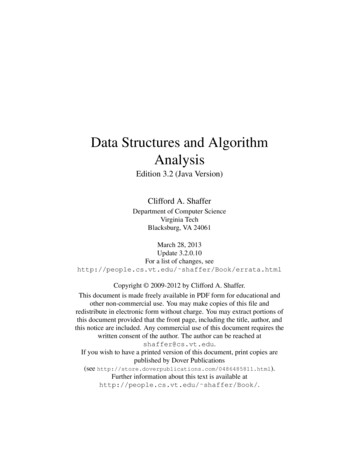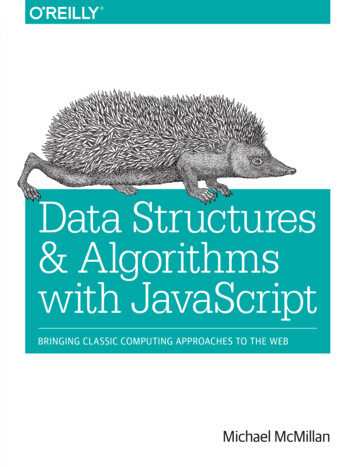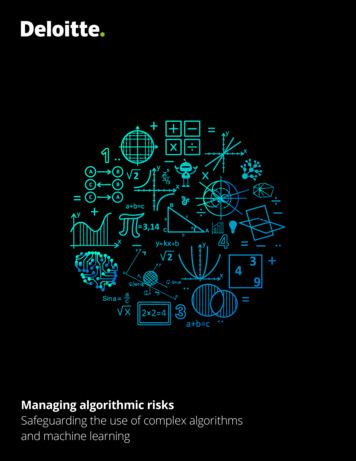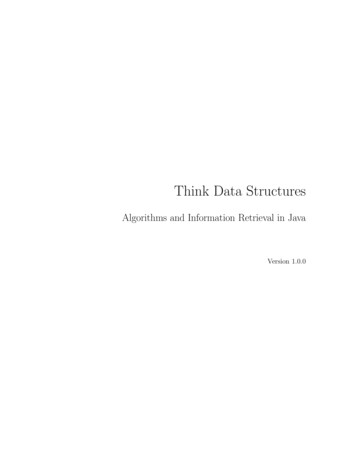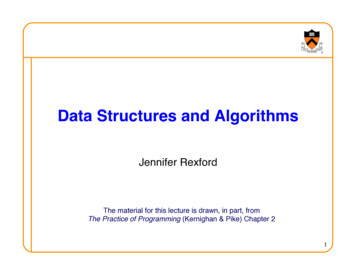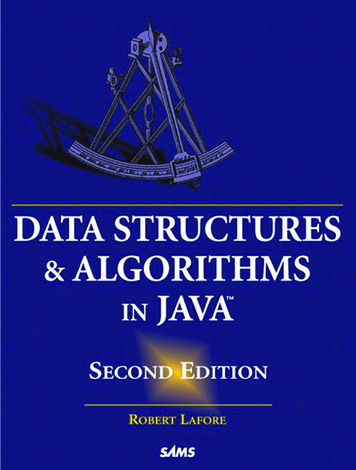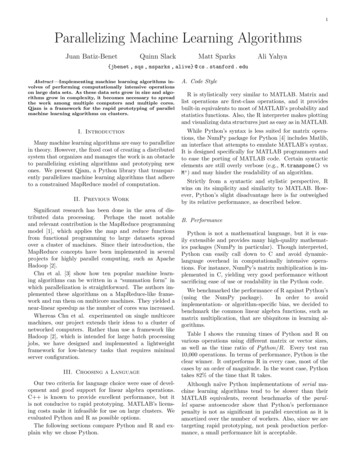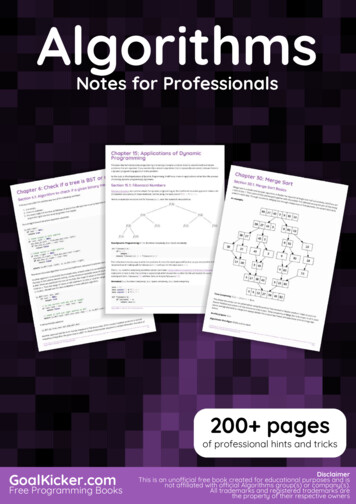
Transcription
CSE373: Data Structures and AlgorithmsLecture 1: Introduction; ADTs; Stacks/QueuesNicki DellSpring 2014
Registration We have 140 students registered and 140 on the wait list!If you’re thinking of dropping the course please decide soon!Wait listed students If you don’t absolutely have to take the course this quarter, it’sunlikely you’ll get in. If you think you absolutely have to take the course this quarter,speak to the CSE undergraduate advisors. They will decide whogets added to the course. UW Employees, Auditors, etc.I will not make individual decisions about registration!CSE 373 Spring 20142
Welcome!We have 10 weeks to learn fundamental data structures andalgorithms for organizing and processing information– “Classic” data structures / algorithms– How to rigorously analyze their efficiency– How to decide when to use them– Queues, dictionaries, graphs, sorting, etc.Today in class: Introductions and course mechanics What this course is about Start abstract data types (ADTs), stacks, and queues– Largely reviewCSE 373 Spring 20143
To-do listIn next 24-48 hours: Adjust class email-list settings Read all course policies Read Chapters 3.1, 3.6 and 3.7 of Weiss book– Relevant to Homework 1, due next week Set up your Java environment for Homework 4sp/CSE 373 Spring 20144
Course staffNicki Dell5th year CSE PhD grad student (loves teaching!)Works with Gaetano Borriello and the Change GroupFun fact: Grew up in Zimbabwe.Office hours, email, etc. on course web-pageCSE 373 Spring 20145
Communication Course email list: cse373a sp14@u.washington.edu– Students and staff already subscribed– You must get announcements sent there– Fairly low traffic Course staff: cse373-staff@cs.washington.edu plusindividual emails Discussion board– For appropriate discussions; TAs will monitor– Encouraged, but won’t use for important announcements Anonymous feedback link– For good and bad: if you don’t tell me, I don’t knowCSE 373 Spring 20146
Course meetings Lecture (Nicki)– Materials posted, but take notes– Ask questions, focus on key ideas (rarely coding details) Optional sections on Tuesday/Thursday afternoons– Will post rough agenda a few days in advance– Help on programming/tool background– Helpful math review and example problems– Again, optional but helpful– May cancel some later in course (experimental) Office hours– Use them: please visit me– Ideally not just for homework questions (but that’s great too)CSE 373 Spring 20147
Course materials All lecture and section materials will be posted– But they are visual aids, not always a complete description!– If you have to miss, find out what you missed Textbook: Weiss 3rd Edition in Java A good Java reference of your choosing– Don’t struggle Googling for features you don’t understandCSE 373 Spring 20148
Computer Lab College of Arts & Sciences Instructional Computing Lab– http://depts.washington.edu/aslab/– Or your own machine Will use Java for the programming assignments Eclipse is recommended programming environmentCSE 373 Spring 20149
Course Work 6 homeworks (60%)– Most involve programming, but also written questions– Higher-level concepts than “just code it up”– First programming assignment due week from Wednesday Midterm Wednesday May 7, in class (15%)Final exam: Tuesday June 10, 2:30-4:20PM (25%)CSE 373 Spring 201410
Collaboration and Academic Integrity Read the course policy very carefully– Explains quite clearly how you can and cannot get/providehelp on homework and projects Always explain any unconventional action on your part– When it happens, when you submit, not when asked I take academic integrity extremely seriously– I offer great trust but with little sympathy for violations– Honest work is a vital feature of a universityCSE 373 Spring 201411
Some details You are expected to do your own work– Exceptions (group work), if any, will be clearly announced Sharing solutions, doing work for, or accepting work from othersis cheating Referring to solutions from this or other courses from previousquarters is cheating But you can learn from each other: see the policyCSE 373 Spring 201412
Advice on how to succeed in 373 Get to class on time!– I will start and end promptly– First 2 minutes are much more important than last 2!– Midterms will prove beyond any doubt you are able to do so Learn this stuff– It is at the absolute core of computing and software– Falling behind only makes more work for you Do the work and try hard This stuff is powerful and fascinating, so have fun with it!CSE 373 Spring 201413
Today in Class Course mechanics: Did I forget anything? What this course is about Start abstract data types (ADTs), stacks, and queues– Largely reviewCSE 373 Spring 201414
What this course will cover Introduction to Algorithm Analysis Lists, Stacks, Queues Trees, Hashing, Dictionaries Heaps, Priority Queues Sorting Disjoint Sets Graph Algorithms Introduction to Parallelism and ConcurrencyCSE 373 Spring 201415
Assumed background Prerequisite is CSE143 Topics you should have a basic understanding of:– Variables, conditionals, loops, methods, fundamentals ofdefining classes and inheritance, arrays, single linked lists,simple binary trees, recursion, some sorting and searchingalgorithms, basic algorithm analysis (e.g., O(n) vs O(n2) andsimilar things) We can fill in gaps as needed, but if any topics are new, plan onsome extra studyingCSE 373 Spring 201416
Goals Deeply understand the basic structures used in all software– Understand the data structures and their trade-offs– Rigorously analyze the algorithms that use them (math!)– Learn how to pick “the right thing for the job”– More thorough and rigorous take on topics introduced inCSE143 (plus more new topics) Practice design, analysis, and implementation– The mix of “theory” and “engineering” at the core ofcomputer science More programming experience (as a way to learn)CSE 373 Spring 201417
Goals Be able to make good design choices as a developer, projectmanager, etc.– Reason in terms of the general abstractions that come up inall non-trivial software (and many non-software) systems Be able to justify and communicate your design decisionsYou will learn the key abstractions used almost every day in justabout anything related to computing and software.CSE 373 Spring 201418
Data structuresA data structure is a (often non-obvious) way to organizeinformation to enable efficient computation over that informationA data structure supports certain operations, each with a:– Meaning: what does the operation do/return– Performance: how efficient is the operationExamples:– List with operations insert and delete– Stack with operations push and popCSE 373 Spring 201419
Trade-offsA data structure strives to provide many useful, efficient operationsBut there are unavoidable trade-offs:– Time vs. space– One operation more efficient if another less efficient– Generality vs. simplicity vs. performanceWe ask ourselves questions like:– Does this support the operations I need efficiently?– Will it be easy to use (and reuse), implement, and debug?– What assumptions am I making about how my software willbe used? (E.g., more lookups or more inserts?)CSE 373 Spring 201420
Terminology Abstract Data Type (ADT)– Mathematical description of a “thing” with set of operations– Not concerned with implementation details Algorithm– A high level, language-independent description of a step-bystep process Data structure– A specific organization of data and family of algorithms forimplementing an ADT Implementation of a data structure– A specific implementation in a specific languageCSE 373 Spring 201421
Example: Stacks The Stack ADT supports operations:– isEmpty: have there been same number of pops as pushes– push: takes an item– pop: raises an error if empty, else returns most-recentlypushed item not yet returned by a pop– (possibly more operations) A Stack data structure could use a linked-list or an array orsomething else, and associated algorithms for the operations One implementation is in the library java.util.StackCSE 373 Spring 201422
Why usefulThe Stack ADT is a useful abstraction because: It arises all the time in programming (e.g., see Weiss 3.6.3)– Recursive function calls– Balancing symbols in programming (parentheses)– Evaluating postfix notation: 3 4 5 *– Clever: Infix ((3 4) * 5) to postfix conversion (see text) We can code up a reusable library We can communicate in high-level terms– “Use a stack and push numbers, popping for operators ”– Rather than, “create an array and keep indices to the ”CSE 373 Spring 201423
The Queue ADT Operationscreatedestroyenqueuedequeueis emptyGenqueueFEDCBBack Just like a stack except:– Stack: LIFO (last-in-first-out)– Queue: FIFO (first-in-first-out) Just as useful and ubiquitousCSE 373 Spring 2014dequeueAFront24
Circular Array Queue Data StructureQ:0size - 1b c d e ffront// Basic idea only!enqueue(x) {Q[back] x;back (back 1) % size}back // Basic idea only!dequeue() {x Q[front];front (front 1) % size; return x;}CSE 373 Spring 2014What if queue is empty?– Enqueue?– Dequeue?What if array is full?How to test for empty?What is the complexity ofthe operations?Can you find the kthelement in the queue?25
Linked List Queue Data Structurebcdeffrontback// Basic idea only!enqueue(x) {back.next new Node(x);back back.next;}// Basic idea only!dequeue() {x front.item;front front.next;return x;}CSE 373 Spring 2014 What if queue is empty?– Enqueue?– Dequeue?Can list be full?How to test for empty?What is the complexity ofthe operations?Can you find the kthelement in the queue?26
Circular Array vs. Linked ListArray:– May waste unneeded space orrun out of space– Space per element excellent– Operations very simple / fast– Constant-time access to kthelementList:– Always just enough space– But more space per element– Operations very simple / fast– No constant-time access to kthelement– For operation insertAtPosition,must shift all later elements– Not in Queue ADT– For operation insertAtPositionmust traverse all earlier elements– Not in Queue ADTThis is stuff you should know after being awakened in the darkCSE 373 Spring 201427
The Stack ADTAOperations:createdestroypushpoptopis emptyEDCBABCDEFFCan also be implemented with an array or a linked list– This is Homework 1 (which is posted)!– Like queues, type of elements is irrelevantCSE 373 Spring 201428
algorithms for organizing and processing information – “Classic” data structures / algorithms – How to rigorously analyze their efficiency – How to decide when to use them – Queues, dictionaries, graphs, sorting, etc.
